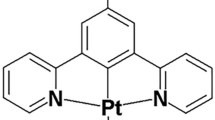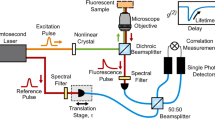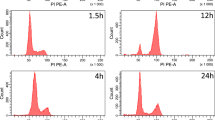Abstract
Diffusion-mediated cellular processes, such as metabolism, signalling and transport, depend on the hydrodynamic properties of the intracellular matrix. Photodynamic therapy, used in the treatment of cancer, relies on the generation of short-lived cytotoxic agents within a cell on irradiation of a drug. The efficacy of this treatment depends on the viscosity of the medium through which the cytotoxic agent must diffuse. Here, spectrally resolved fluorescence measurements of a porphyrin-dimer-based molecular rotor are used to quantify intracellular viscosity changes in single cells. We show that there is a dramatic increase in the viscosity of the immediate environment of the rotor on photoinduced cell death. The effect of this viscosity increase is observed directly in the diffusion-dependent kinetics of the photosensitized formation and decay of a key cytotoxic agent, singlet molecular oxygen. Using these tools, we provide insight into the dynamics of diffusion in cells, which is pertinent to drug delivery, cell signalling and intracellular mass transport.
This is a preview of subscription content, access via your institution
Access options
Subscribe to this journal
Receive 12 print issues and online access
$259.00 per year
only $21.58 per issue
Buy this article
- Purchase on Springer Link
- Instant access to full article PDF
Prices may be subject to local taxes which are calculated during checkout




Similar content being viewed by others
References
Kao, H. P., Abney, J. R. & Verkman, A. S. Determinants of the translational mobility of a small solute in cell cytoplasm. J. Cell Biol. 120, 175–184 (1993).
Jones, D. P. Effect of mitochondrial clustering in O2 supply in hepatocytes. Am. J. Physiol. 247, C83–C89 (1984).
O'Loughlin, M. A., Whillans, D. W. & Hunt, J. W. A fluorescence approach to testing the diffusion of oxygen into mammalian cells. Radiat. Res. 84, 477–495 (1980).
Uchida, K., Matsuyama, K., Tanaka, K. & Doi, K. Diffusion coefficient for O2 in plasma and mitochondrial membranes of rat cardiomyocytes. Respir. Physiol. 90, 351–362 (1992).
Hatz, S., Poulsen, L. & Ogilby, P. R. Time-resolved singlet oxygen phosphorescence measurements from photosensitized experiments in single cells: the effect of oxygen diffusion and oxygen concentration. Photochem. Photobiol. 84, 1284–1290 (2008).
Wojcieszyn, J. W., Schlegel, R. A., Wu, E. S. & Jacobson, K. A. Diffusion of injected macromolecules within the cytoplasm of living cells. Proc. Natl Acad. Sci. USA 78, 4407–4410 (1981).
Seksek, O., Biwersi, J. & Verkman, A. S. Translational diffusion of macromolecule-sized solutes in cytoplasm and nucleus. J. Cell Biol. 138, 131–142 (1997).
Kuimova, M. K., Yahioglu, G., Levitt, J. A. & Suhling, K. Molecular rotor measures viscosity via fluorescence lifetime imaging. J. Am. Chem. Soc. 130, 6672–6673 (2008).
Dix, J. A. & Verkman, A. S. Mapping of fluorescence anisotropy in living cells by ratio imaging—Application to cytoplasmic viscosity. Biophys. J. 57, 231–240 (1990).
Luby-Phelps, K. et al. A novel fluorescence ratiometric method confirms the low solvent viscosity of the cytoplasm. Biophys. J. 65, 236–242 (1993).
Suhling, K. et al. Time-resolved fluorescence anisotropy imaging applied to live cells. Opt. Lett. 29, 584–586 (2004).
Kuimova, M. K., Yahioglu, G. & Ogilby, P. R. Singlet oxygen in a cell: Spatially-dependent lifetimes and quenching rate constants. J. Am. Chem. Soc. 131, 332–340 (2009).
Haidekker, M. A. & Theodorakis, E. A. Molecular rotors—Fluorescent biosensors for viscosity and flow. Org. Biomol. Chem. 5, 1669–1678 (2007).
Haidekker, M. A., Brady, T. P., Lichlyter, D. & Theodorakis, E. A. A ratiometric fluorescent viscosity sensor. J. Am. Chem. Soc. 128, 398–399 (2006).
Perrin, F. La fluorescence des solutions: induction moléculaire. Polarisation et durée d'emission. Photochimie. Ann. Phys. (Paris) 12, 169–275 (1929).
Shinitzky, M., Dianoux, A. C., Gitler, C. & Weber, G. Microviscosity and order in the hydrocarbon region of micelles and membranes determined with fluorescent probes. I. Synthetic micelles. Biochemistry 10, 2106–2113 (1971).
Collins, H. A. et al. Blood vessel closure using photosensitisers engeneered for two-photon excitation. Nature Photon. 2, 420–424 (2008).
Balaz, M., Collins, H. A., Dahlstedt, E. & Anderson, H. L. Synthesis of biocompatible conjugated porphyrin dimers for one-photon and two-photon excited photodynamic therapy at NIR wavelengths. Org. Biomol. Chem. 7, 874–888, doi:10.1039/b814789b (2009).
Kuimova, M. K. et al. Photophysical properties and intracellular imaging of water-soluble porphyrin dimers for two-photon excited photodynamic therapy. Org. Biomol. Chem. 7, 889–896, doi:10.1039/b814791d (2009).
Dahlstedt, E. et al. One- and two-photon activated phototoxicity of conjugated porphyrin dimers with high two-photon absorption cross-sections. Org. Biomol. Chem. 7, 897–904, doi:10.1039/b814792b (2009).
Bonnett, R. Chemical Aspects of Photodynamic Therapy (Gordon and Breach, 2000).
Winters, M. U. et al. Photophysics of a butadiyne-linked porphyrin dimer: Influence of conformational flexibility in the ground and first singlet excited state. J. Phys. Chem. C 111, 7192–7199 (2007).
Förster, T. & Hoffmann, G. Viscosity dependence of fluorescent quantum yields of some dye systems. Z. Phys. Chem. 75, 63–76 (1971).
Borissevitch, I. E., Tominaga, T. T. & Schmitt, C. C. Photophysical studies on the interaction of two water-soluble porphyrins with bovine serum albumin. Effects upon the porphyrin triplet state characteristics. J. Photochem. Photobiol. A 114, 201–207 (1998).
Lang, K., Mosinger, J. & Wagnerova, D. M. Photophysical properties of porphyrinoid sensitizers non-covalently bound to host molecules; models for photodynamic therapy. Coord. Chem. Rev. 248, 321–350 (2004).
Zunszain, P. A., Ghuman, J., Komatsu, T., Tsuchida, E. & Curry, S. Crystal structural analysis of human serum albumin complexed with hemin and fatty acid. BMC Struct. Biol. 3: 6 (2003).
Goosey, J. D., Zigler, J. S. & Kinoshita, J. H. Cross-linking of lens crystallins in a photodynamic system—A process mediated by singlet oxygen. Science 208, 1278–1280 (1980).
Dubbelman, T., Degoeij, A. & Vansteveninck, J. Photodynamic effects of protoporphyrin on human erythrocytes—A nature of cross-linking of membrane proteins. Biochim. Biophys. Acta 511, 141–151 (1978).
Verweij, H., Dubbelman, T. & Vansteveninck, J. Photodynamic protein cross-linking. Biochim. Biophys. Acta 647, 87–94 (1981).
Basu, S., Rodionov, V., Terasaki, M. & Campagnola, P. J. Multiphoton-excited microfabrication in live cells via Rose Bengal cross-linking of cytoplasmic proteins. Opt. Lett. 30, 159–161 (2005).
Hatz, S., Lambert, J. D. C. & Ogilby, P. R. Measuring the lifetime of singlet oxygen in a single cell: Addressing the issue of cell viability. Photochem. Photobiol. Sci. 6, 1106–1116 (2007).
Snyder, J. W., Skovsen, E., Lambert, J. D. C. & Ogilby, P. R. Subcellular, time-resolved studies of singlet oxygen in single cells. J. Am. Chem. Soc. 127, 14558–14559 (2005).
Battino, R. (ed.) Oxygen and Ozone. Solubility Data Series 7 (Pergamon, 1981).
Acknowledgements
M.K.K. is grateful to the EPSRC Life Sciences Interface programme for a personal fellowship. We thank STFC for funding access to the Central Laser Facility. This work was supported in part by the Danish National Research Foundation under a block grant for the Center for Oxygen Microscopy and Imaging.
Author information
Authors and Affiliations
Contributions
M.K.K. designed the research, M.K.K., S.W.B. and A.W.P. measured fluorescence spectra, M.K.K. performed ratiometric imaging and measured singlet-oxygen traces. M.B. and H.A.C. synthesized the porphyrin dimer. All authors discussed the results and contributed to the manuscript.
Corresponding authors
Supplementary information
Supplementary information
Supplementary information (PDF 422 kb)
Rights and permissions
About this article
Cite this article
Kuimova, M., Botchway, S., Parker, A. et al. Imaging intracellular viscosity of a single cell during photoinduced cell death. Nature Chem 1, 69–73 (2009). https://doi.org/10.1038/nchem.120
Received:
Accepted:
Published:
Issue Date:
DOI: https://doi.org/10.1038/nchem.120
This article is cited by
-
Golgi-targeting viscosity probe for the diagnosis of Alzheimer’s disease
Scientific Reports (2024)
-
Enhancing photodynamic inactivation via tunning spatial constraint on photosensitizer
Science China Chemistry (2024)
-
Precise visualization and ROS-dependent photodynamic therapy of colorectal cancer with a novel mitochondrial viscosity photosensitive fluorescent probe
Biomaterials Research (2023)
-
Directly imaging emergence of phase separation in peroxidized lipid membranes
Communications Chemistry (2023)
-
Fluorescence and phosphorescence lifetime imaging reveals a significant cell nuclear viscosity and refractive index changes upon DNA damage
Scientific Reports (2023)



